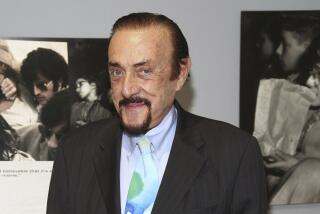Louis Zamperini dies at 97; Olympic track star and WWII hero
- Share via
The government announcement of Louis Zamperini’s death in World War II made headlines.
Zamperini was the “Torrance Tornado,” the tough kid turned track star who set a national high school record for running the mile. In 1936, he was known as “The Zamp,” the 18-year-old USC standout who ran at the Berlin Olympics, where his roommate was Jesse Owens. In 1943, he was Lt. Zamperini, a bombardier on a B-24 Liberator, who, along with 10 other crew members, fell off the map on a May 27 mission over the Pacific.
When President Franklin D. Roosevelt sent his parents a formal condolence note in 1944, he had no idea that Zamperini was still alive and living a nightmare in a Japanese prison camp. For 47 days, Zamperini had drifted on a life raft, fighting off sharks and starvation with two other crew members, one of whom died. Picked up by a Japanese patrol boat, the two survivors were beaten, tortured and humiliated for more than two years.
After the war, Zamperini was told by an Army superior that his raft trip qualified him for $7.60 a day in reimbursement. But someone higher up in the command rejected it: “Request denied,” the letter said. “Travel unauthorized.”
Zamperini, who became an inspirational speaker and evangelical Christian youth worker after returning from the war emotionally battered, died at his Los Angeles home Wednesday — 70 years after the mistaken government announcement. He was 97.
His death from pneumonia was confirmed by a spokesman for Universal Pictures, which is scheduled to release a film based on Zamperini’s life in December.
An athlete who stayed trim his entire life, Zamperini gave up skateboarding at 81. Ten years later, he gave up skiing. He was fit enough to be picked as grand marshal of the 2015 Rose Parade. He often credited his years of rigorous training and competition with helping him survive the ordeal of war.
“The only way I can put it that makes sense is that every athlete wants to win,” he said on CBS’ “The Early Show” in 2001.
A Tournament of Roses spokeswoman said Thursday that Zamperini will be honored at the 2015 parade. No grand marshal will be named to replace him.
Zamperini’s remarkable life story is the subject of “Unbroken,” the film based on Laura Hillenbrand’s best-selling book of the same name.
“His wasn’t a sad story,” Hillenbrand said Thursday. “It was a triumph. He left behind a lesson in the breadth of possibility for all of us, and in forgiveness.”
Zamperini’s tale had been simmering on Hollywood’s back burner for decades. In 1957, Universal Pictures bought the rights to his memoir, “Devil at My Heels.” Producers even penciled in actor Tony Curtis for the leading role, but “Spartacus” came along and the project was dropped. Zamperini’s saga languished.
“The story was as vast as the ocean waters in which Zamperini had floated for nearly two months,” then-Times film reporter John Horn wrote in April. Producers and writers “simply had too much material, and no one could figure out precisely which parts of his story to tell and which to leave behind.”
Intrigued by Hillenbrand’s 2010 book, actress Angelina Jolie pushed the film into production. She directed it as well.
As it turned out, her home in the Hollywood Hills was a stroll away from the one Zamperini owned for more than 50 years.
“I imagine that for the last 10-something years, he’s been sitting there having a coffee in the morning and wondering, ‘Who’s going to make this movie?’ ” Jolie said in a February interview on NBC’s “Today” show. “And I’ve been sitting in my room thinking, ‘What am I supposed to be doing with my life?’ “
Zamperini’s life was the stuff movies are made of.
In the 1930s, he was an emerging track star, a two-time NCAA champion in the mile at USC and a likely candidate to break the four-minute mile. At the Berlin Olympics, he finished eighth in the 5,000-meter run and afterward shook hands with Adolf Hitler, who called him the “boy with the fast finish.”
He was a sure thing for the 1940 Olympics, but they never materialized. Planned for Tokyo, the Games were canceled when the war broke out.
As a flier in the Pacific, Zamperini was part of a crew trying to find a downed plane when his aircraft developed engine trouble and plunged into the Pacific hundreds of miles south of Hawaii.
“The plane exploded,” he told the CBS program “48 Hours” in 1999. “I felt like someone hit me on the forehead with a sledgehammer. My head comes out of the water. It looks just like the world just stood still for a moment.”
Only three of the 11 men on board survived the crash and another died before Zamperini and 2nd Lt. Russell Phillips were captured by a Japanese patrol ship in the Marshall Islands.
Zamperini and Phillips survived on rain water and whatever fish they could catch. Famished and besieged by sharks, they kept their wits with mental exercises. When Zamperini meticulously narrated the preparation of an elaborate dinner, “the men would devour every crumb, describing every mouthful,” Hillenbrand recounted in “Unbroken.”
By the time of their capture, Zamperini had drifted 2,000 miles and weighed less than 100 pounds.
Zamperini was among prisoners who were given mysterious injections to test their reactions. He was particularly tormented by a soldier named Mutsuhiro Watanabe, whom the prisoners called the Bird and who “would dedicate himself to shattering” Zamperini, Hillenbrand wrote.
“I could take the beatings and the physical punishment, but it was the attempt to destroy your dignity, to make you a nonentity, that was the hardest thing to bear,” Zamperini told the New York Times in 2003.
After Zamperini was declared dead in 1944, the airport in Torrance was named after him and, years later, so was the Torrance High School stadium.
The first sign that the downed flier was alive came in November 1944, when Radio Tokyo broadcast a greeting to his parents. But Zamperini refused to cooperate for a second broadcast, when his captors wanted him to read a statement that was critical of the United States.
As a result, Zamperini, who was promoted to captain while in captivity, was sent to “punishment camp.”
“My first thought was anything is better than going back to the Bird. If I get away from him, I don’t care where I go,” he told “48 Hours.”
Unfortunately, the new camp’s commander was the Bird, who continued to torture Zamperini until the war’s end.
Louis Silvie Zamperini was born Jan. 26, 1917, in Olean, N.Y., the second of four children of Louise and Anthony Zamperini. His father, who was born in Italy and came to the United States as a teenager, started working in a coal mine, then in construction.
The family eventually settled in Torrance, where Zamperini, bullied for his limited English, was smoking, drinking, and committing petty thefts before he was a teenager.
“I had to follow my own path,” he wrote in “Devil at My Heels.” “More and more that meant getting into trouble.’’
His older brother Pete Zamperini told “48 Hours” in 1999: “Louie was a pain in the neck. In the old days we only had one police car in town. So if it went south, Louie went north.”
Pete helped persuade his brother to use his speed for track rather than outrunning authorities. It didn’t take long for him to start winning races — and doing so spectacularly.
After the war, Zamperini returned home a hero but deep scars remained.
“Every night the Bird came into my nightmare,” Zamperini said. “No matter what other nightmares I had … I was always strangling him with my hands around his throat.”
He struggled with alcoholism and nearly lost his marriage until his wife, Cynthia Applewhite, whom he married in 1946, persuaded him to see evangelist Billy Graham preach in 1949.
Zamperini stormed out of the tent meeting but reluctantly agreed to return another night. This time Graham’s message “caused me to turn my life around,” Zamperini wrote in “Devil at My Heels.”
“I dropped to my knees and for the first time in my life truly humbled myself before the Lord,” he wrote. “I made no excuses. I did not rationalize, I did not blame.”
Zamperini’s wife died in 2001. His survivors include daughter Cynthia, son Luke and a grandchild.
Zamperini started sharing his story with church groups. In 1950, he returned to Japan and offered his forgiveness to his former captors, many of whom were imprisoned as war criminals. He later worked in commercial real estate, ran church programs for youngsters and senior citizens, and started a camp for youths in trouble.
And he regained a connection to the Olympics. Zamperini carried the Olympic torch for the 1984 Summer Games in Los Angeles and for the 1998 Winter Games in Nagano, Japan, near one of the camps where he was tortured.
“I figure the war took 10 years off my life,” Zamperini told The Times in 2002. “I decided to get those 10 years back.”
Thursby is a former Times staff writer.
Twitter:@schawkins
More to Read
Start your day right
Sign up for Essential California for the L.A. Times biggest news, features and recommendations in your inbox six days a week.
You may occasionally receive promotional content from the Los Angeles Times.







